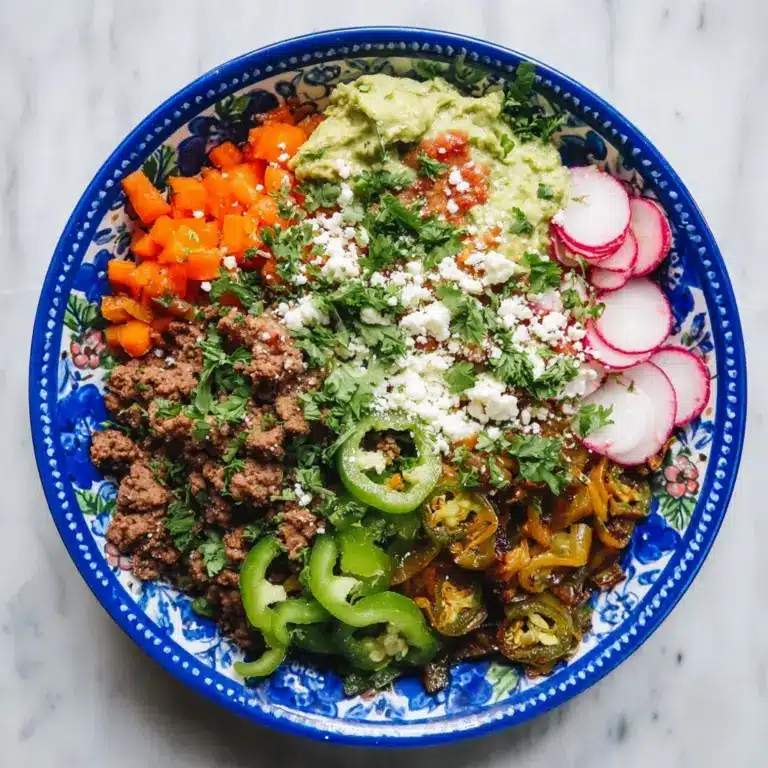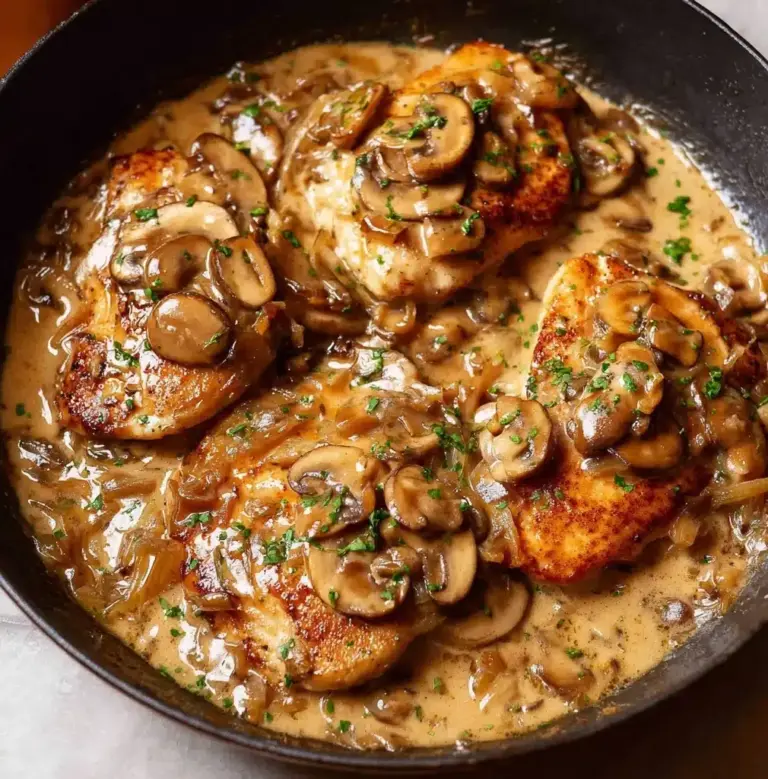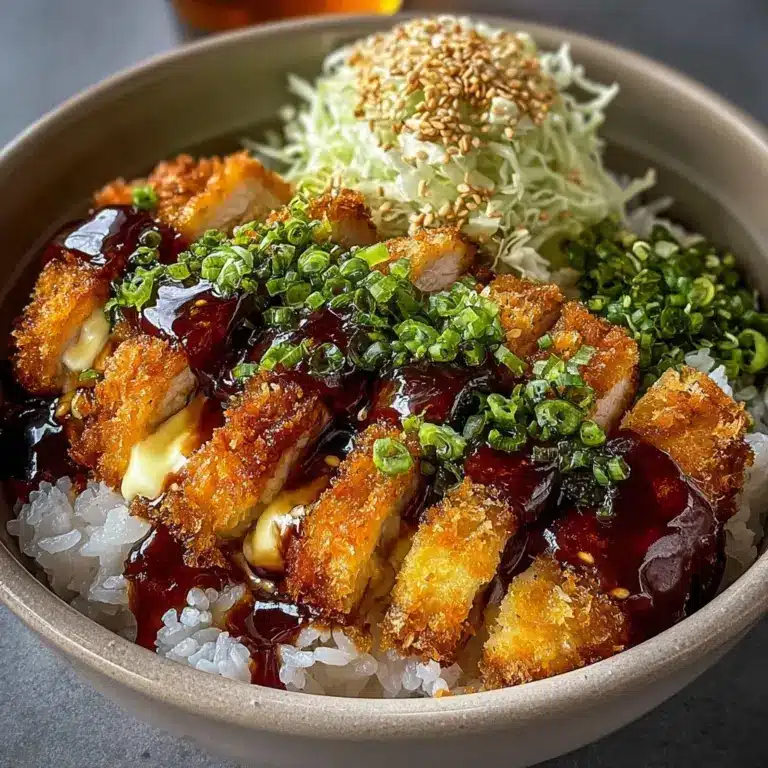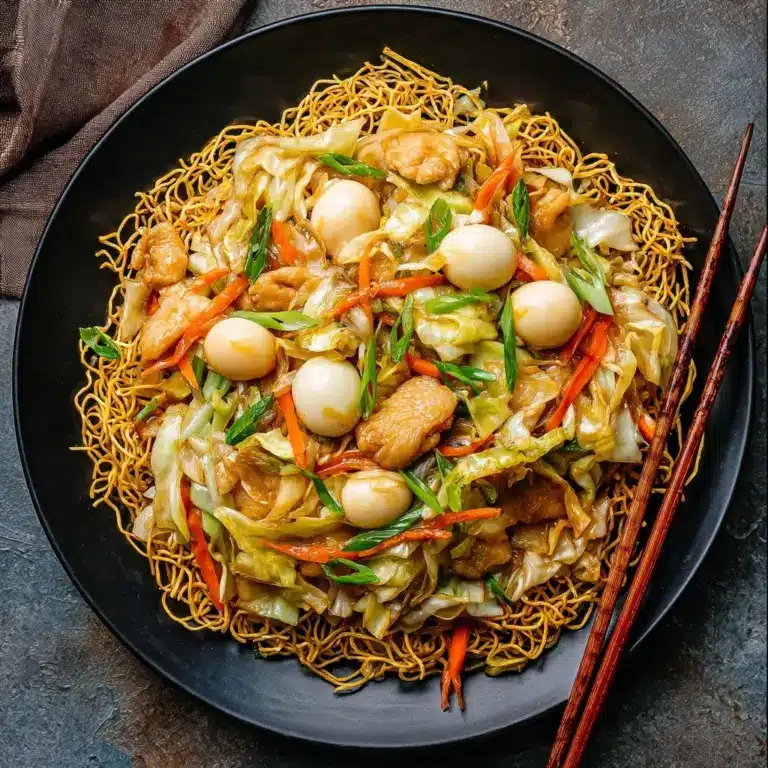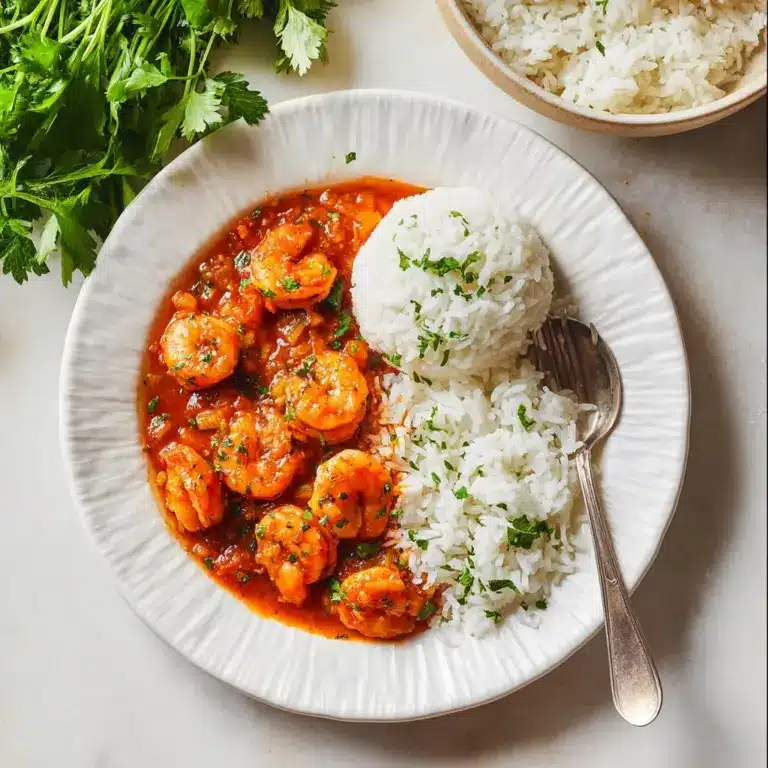Japchae (Korean Noodles) Recipe
Japchae (Korean Noodles) is a vibrant, flavor-packed dish that instantly makes any meal feel like a celebration. These springy sweet potato noodles are tossed with tender marinated steak, a garden’s worth of sautéed veggies, ribbons of egg, and glossy sesame-soy sauce. Every bite tastes like comfort and festivity all wrapped up in one colorful package. Whether you’re hosting a dinner party or just hungry for something extraordinary, Japchae (Korean Noodles) lights up your table and your taste buds.
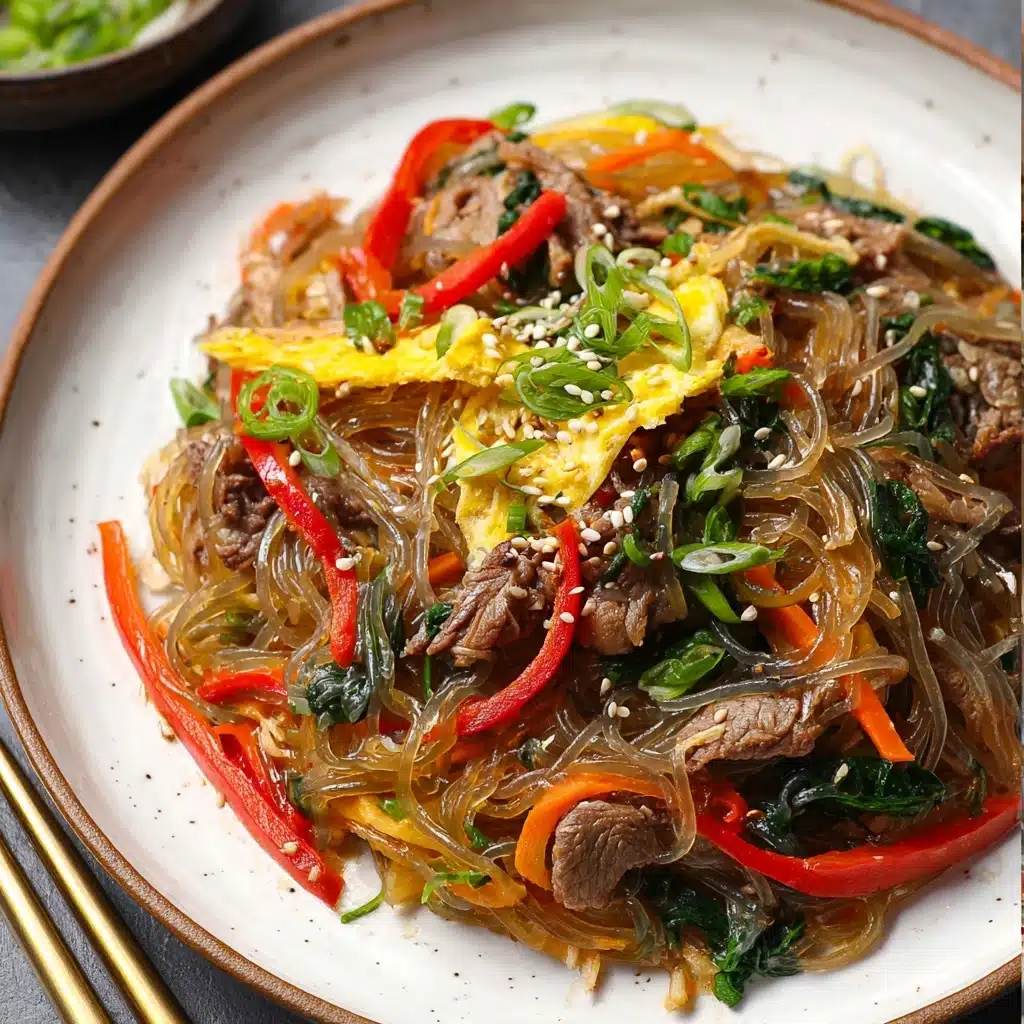
Ingredients You’ll Need
The beauty of Japchae (Korean Noodles) is just how much flavor you can coax out of everyday ingredients, each playing its own unique part. Fresh produce, simple sauces, and a few thoughtful seasonings layer together for a dazzling result.
- Soy Sauce: The foundation for both flavor and color, giving the dish its iconic sweet-savory depth.
- Sugar: Adds just the right sweetness to balance the salty and earthy flavors.
- Sesame Seed Oil: This deeply aromatic oil finishes the noodles with a rich, nutty fragrance.
- Mirin: A sweet rice wine that rounds out the marinade with mild acidity.
- Garlic (minced): Because every great Korean dish boasts bold, garlicky undertones.
- Ribeye Steak (thinly sliced): Adds luxurious texture and savory richness—you can substitute with chicken or tofu for another twist!
- Sesame Seeds: For irresistible crunch and a toasty finishing touch.
- Black Pepper: Lends a gentle, warming kick to the sauce.
- Sweet Potato Noodles: These chewy, glossy noodles are Japchae’s signature—if you can’t find them, glass noodles or even vermicelli will work in a pinch.
- Fresh Spinach: Adds bright green pops and a fresh, earthy lift.
- Neutral Oil: Keeps all your veggies glistening without overpowering their flavors—think canola or grapeseed.
- Eggs (lightly beaten): Transformed into delicate strips, they add both protein and sunny color.
- Shiitake Mushrooms (thinly sliced): Give Japchae (Korean Noodles) a deep, umami punch; both fresh and rehydrated dried mushrooms are fantastic.
- Onion (sliced thin): Brings sweetness once sautéed and melds effortlessly with the sauce.
- Carrot (matchsticked): Contributes vibrant color and tenderness.
- Red Bell Pepper (sliced thin): For a crisp crunch and eye-catching red hue.
- Salt: Just enough to pull everything into balance—taste as you go!
- Scallions (chopped): The classic final flourish for color, freshness, and that unmistakable hint of allium.
How to Make Japchae (Korean Noodles)
Step 1: Marinate the Beef
Start your Japchae (Korean Noodles) adventure by whisking together soy sauce, sugar, sesame seed oil, mirin, and garlic in a bowl until the sugar dissolves into a sweet-salty magic potion. Nestle the thinly sliced ribeye steak in this marinade, coating every piece, and let it soak up those flavors while you prep the other ingredients.
Step 2: Mix the Japchae Noodle Sauce
In a small bowl or measuring cup, combine sesame seed oil, soy sauce, sugar, sesame seeds, and black pepper. Mix until the sugar is dissolved and the mixture gleams. This sauce is the backbone of flavor that will cling to every strand of noodle and each veggie.
Step 3: Cook the Sweet Potato Noodles
Bring a big pot of water to a rolling boil and cook your sweet potato noodles according to the package’s directions. Once they’re perfectly chewy, transfer them to a sieve and rinse under cold water to stop the cooking. Give them a thorough drain—even a gentle rub with a towel if they’re overly wet. Place them in your largest bowl, cut them with scissors if they’re super long, and toss with two-thirds of your earlier Japchae Noodle Sauce.
Step 4: Prepare Vegetables and Eggs
While your noodle water is still hot, salt it and quickly blanch the spinach. Run it under cool water to halt the cooking, then squeeze out the excess liquid. Lay the spinach on top of your noodles for now. In a skillet, add a touch of oil and pour in the beaten eggs, letting them set into a thin crepe. Slip it out when just cooked, and set aside to cool.
Step 5: Sauté Mushrooms, Veggies, and Beef
Wipe out your pan and sauté the shiitake mushrooms with a pinch of salt until they’re wilted and aromatic. Next, use another splash of oil to cook the onions, carrots, and bell pepper together—they only need a couple of minutes to soften and develop flavor. Finally, crank the heat and swiftly sear the marinated beef, just until browned and tender. Layer everything onto the bowl of noodles.
Step 6: Finish and Toss
Roll up the cooled egg crepe and slice it into ribbons. Scatter the egg over the top. Pour on the remaining Japchae Noodle Sauce, then, using impeccably clean hands (or food-safe gloves), toss everything together ever so gently. Each noodle strand should pick up some sauce, every color mingling joyfully. Taste and adjust the seasoning one last time as needed.
Step 7: Serve with Garnish
Transfer the beautiful jumble of Japchae (Korean Noodles) to a serving platter. For the finishing touch, sprinkle with fresh scallions and another flurry of toasted sesame seeds. This dish is irresistible hot, warm, or even at room temperature, making it a lovely option for gatherings.
How to Serve Japchae (Korean Noodles)
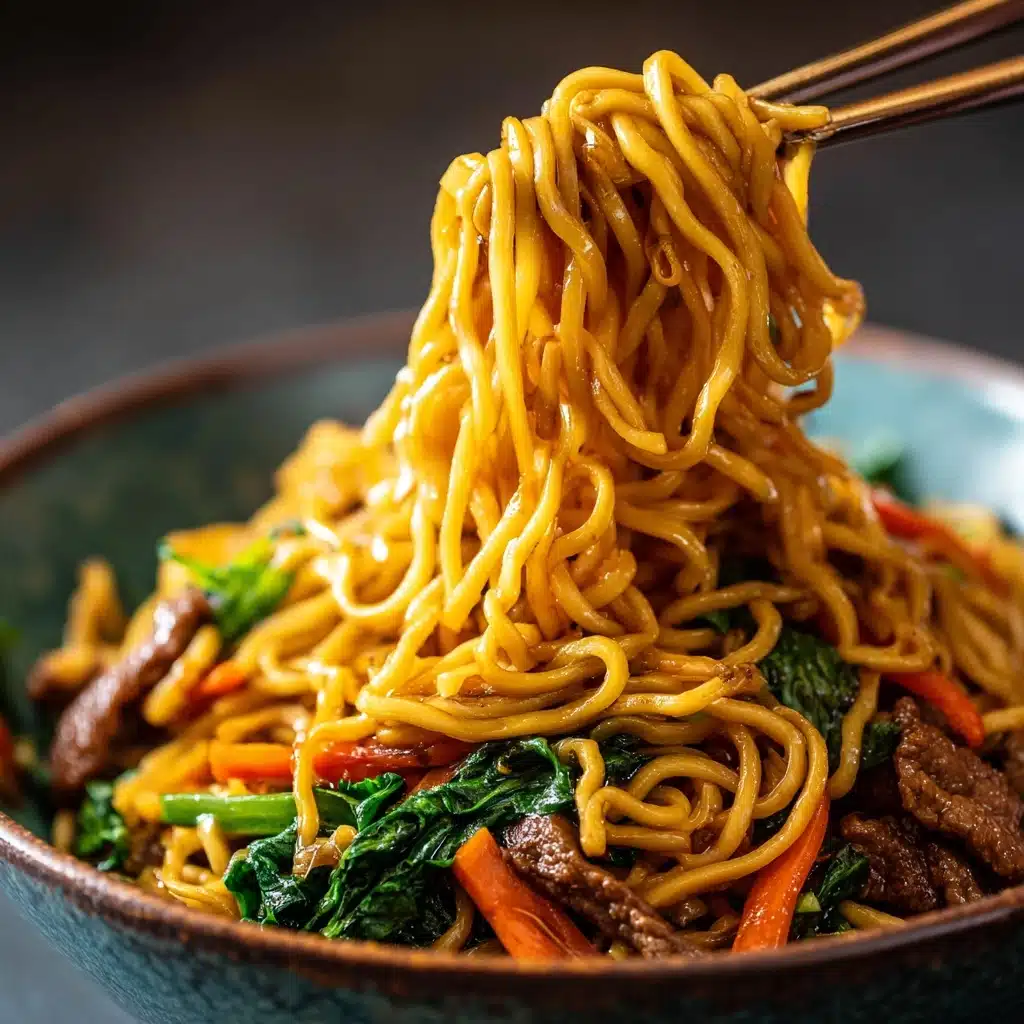
Garnishes
Japchae (Korean Noodles) absolutely shines with a generous scatter of chopped scallions and roasted sesame seeds. If you want even more texture and color, add a sprinkle of shredded nori or a few threads of red pepper (gochugaru). The cool freshness of garnish balances the warmth and savoriness of the noodles.
Side Dishes
Traditionally, Japchae (Korean Noodles) pairs beautifully with Korean banchan—think quick cucumber pickles, kimchi, or spicy radish. A simple miso soup or a light Asian-style salad work equally well and make your meal sing with balanced flavors.
Creative Ways to Present
You can roll Japchae (Korean Noodles) in lettuce leaves for a playful, hands-on meal, or mound it neatly in small bowls for an elegant appetizer. For parties, try arranging the toppings in sections atop the noodles, letting guests mix to their heart’s delight.
Make Ahead and Storage
Storing Leftovers
Japchae (Korean Noodles) stores like a champion! Simply pop your leftovers into an airtight container and refrigerate. The noodles absorb even more flavor as they rest, making tomorrow’s serving just as delicious. Enjoy within 3-4 days for the best taste and texture.
Freezing
While you can freeze Japchae (Korean Noodles), be aware that the noodle texture may get a bit softer upon thawing. For best results, portion into single servings, wrap tightly, and freeze for up to 1 month. When you’re ready to eat, let it thaw overnight in the refrigerator before reheating.
Reheating
To revive Japchae (Korean Noodles), gently warm in a non-stick skillet over medium heat, adding a splash of water or a drizzle of sesame oil to loosen them up. A quick turn in the microwave also works—just cover so they don’t dry out. Don’t worry if they taste even better the next day!
FAQs
Can I make Japchae (Korean Noodles) vegetarian or vegan?
Absolutely! Just skip the steak or swap it with tofu or more mushrooms. Also, leave out the eggs or use your favorite plant-based egg alternative for a totally vegan version.
Do I have to use sweet potato noodles?
Sweet potato noodles are traditional and give Japchae (Korean Noodles) its classic, delightfully chewy character, but you can substitute with glass noodles, vermicelli, or even soba in a pinch—the dish will still be delicious.
My noodles got sticky—what can I do?
If your Japchae (Korean Noodles) clump together, just add a drizzle more sesame oil and toss thoroughly. Cutting the noodles slightly shorter and ensuring they’re well-rinsed after cooking helps, too.
Can I make Japchae (Korean Noodles) ahead for a party?
Definitely! This dish is tailor-made for entertaining, since it’s great at room temperature. Assemble everything a few hours before serving and give it a fresh toss with extra sauce or oil just before guests arrive.
What protein can I use instead of beef?
Try thinly sliced chicken, pork, or even shrimp! Tofu is a fantastic plant-based option as well. Whatever you choose, marinate and cook as directed for amazing results in your Japchae (Korean Noodles).
Final Thoughts
If you’re ready for bright colors, incredible flavors, and all the feel-good vibes, don’t hesitate—Japchae (Korean Noodles) is the dish to bring everyone together around your table. Give it a try, and I promise it’ll be a new favorite in your repertoire!
Print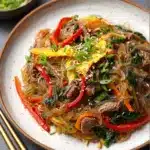
Japchae (Korean Noodles) Recipe
- Total Time: 1 hour
- Yield: 4 servings 1x
- Diet: Vegetarian
Description
Delicious and authentic Japchae recipe with sweet potato noodles, marinated beef, and colorful vegetables, tossed in a flavorful sauce.
Ingredients
Beef Marinade:
- 1 tablespoon soy sauce
- 1 tablespoon sugar
- 2 teaspoons sesame seed oil
- 2 teaspoons mirin
- 1 clove garlic, minced
- 10 ounces ribeye steak, boneless and thinly sliced
Japchae Noodle Sauce:
- 1/4 cup sesame seed oil
- 1/4 cup soy sauce
- 3 tablespoons sugar
- 1 tablespoon sesame seeds
- 1/2 teaspoon black pepper
Other Ingredients:
- 10 oz sweet potato noodles or glass noodles
- 6 oz fresh spinach
- 1 tablespoon neutral oil, divided
- 2 eggs, lightly beaten
- 6 shiitake mushrooms, thinly sliced
- 1/2 onion, thinly sliced
- 1 medium to large carrot, cut into matchsticks
- 1 red bell pepper, thinly sliced
- Salt, to taste
- Scallions and sesame seeds for garnish
Instructions
- Beef + Marinade: Whisk together soy sauce, sugar, sesame oil, mirin, and garlic. Marinate sliced rib-eye in the mixture.
- Japchae Noodle Sauce: Combine sesame seed oil, soy sauce, sugar, sesame seeds, and black pepper in a bowl.
- Cook sweet potato noodles: Cook noodles, drain, and mix with 2/3 of the sauce.
- Cook veggies, eggs, and marinated beef: Prepare and cook spinach, eggs, mushrooms, onions, carrots, bell pepper, and beef separately.
- Final touches: Combine all cooked ingredients with remaining sauce. Adjust seasoning and serve garnished with scallions and sesame seeds.
Notes
- You can substitute sweet potato noodles with glass noodles.
- Rehydrate dried shiitake mushrooms before slicing.
- Cut noodles with scissors if too long.
- Adjust seasoning to taste.
- Prep Time: 30 minutes
- Cook Time: 30 minutes
- Category: Main Course
- Method: Stovetop
- Cuisine: Korean
Nutrition
- Serving Size: 1 serving
- Calories: 450 kcal
- Sugar: 8g
- Sodium: 800mg
- Fat: 20g
- Saturated Fat: 5g
- Unsaturated Fat: 12g
- Trans Fat: 0g
- Carbohydrates: 45g
- Fiber: 4g
- Protein: 25g
- Cholesterol: 80mg
Keywords: Japchae, Korean noodles, sweet potato noodles, stir fry

